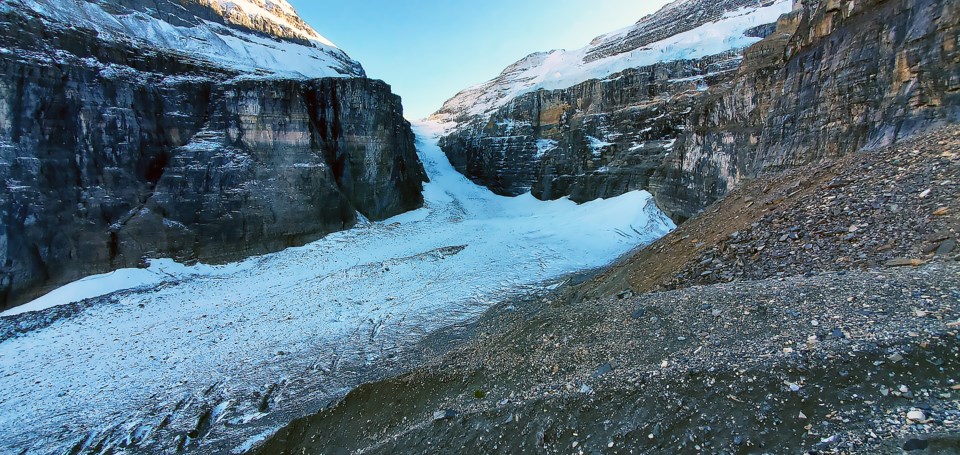Canmore residents and visitors to the Rockies need no introduction to the stunning beauty of the mountains. Recognizing there is something remarkable and immensely meaningful about the landscapes around us is easy; articulating why, on the other hand, can be a challenge.
What makes the mountains meaningful to us? And how do we convey that meaning?
These questions are central to the International Year of Glaciers’ Preservation (IYGP), declared by the United Nations for 2025. We are proud to announce Canmore will be a world centre of activity in support of this important UN year and grateful the Outlook has permitted us to periodically report on our progress in sharing what we know and are learning about glaciers with locals and visitors alike.
In this OpEd, we would like to report we have created a team of researchers, scientists, and citizens who are developing Canada’s contribution to this global campaign and whose activities will be based here in Canmore leading up to and throughout the year. As a prelude to this introduction, however, it’s first necessary to offer some clarifications.
Although this initiative is called the International Year of Glaciers’ Preservation, it is not a save the glaciers campaign. Because of the time lag between the extent to which we have changed the composition of the global atmosphere by way of accumulating carbon emissions, and when later those changes express themselves as direct effects on climate, even if we stopped all carbon emissions today, it would be centuries before our glaciers would cease in their recession.
All we can do now is to slow that recession as much as possible, appreciate our remaining glaciers for their stunning beauty while we can, and at the same time learn as much as possible about what their recession is telling us about our climate future.
We are not a climate action lobby group – though we do believe climate action is necessary – nor do we have a specific political agenda, though we do hope politicians will take note.
Instead, we are a volunteer committee working to honour the past, present and future of Canada’s glacial legacy. Our mission is to highlight what changes in snow and ice mean for freshwater availability, ecosystems, communities, industries and hazard risk, both here in the mountains as well as downstream. But it is not all about science.
In honour of this mission, you can expect a celebration in 2025. We will celebrate Canadian researchers and institutions studying snow and ice, artists and photographers capturing winter’s beauty, the knowledge and understanding of the land offered by Indigenous peoples and the intimate perspectives of mountain guides and backcountry dwellers. We will work with – and thank – the local and global organizations helping communities adapt to snow and ice changes, as well as those advocating for a better future, using the IYGP as a reminder of why such work is necessary.
The Glacier Year will begin in January, and our team is spending the months leading up to it finding ways to make it meaningful. Thanks to the Outlook, we will be publishing a series of OpEd’s on glaciers, including the science behind snow and ice changes, their various impacts and related concerns, and importantly, reasons to be hopeful. If you are interested in working with us, we welcome you. You can find our contact on the Canada IYGP website: www.unglacieryear.ca.
If you want a taste of what is to come in 2025, then please join us on March 21, 2024, the soon-to-become World Day for Glaciers. We are holding an online Zoom webinar introducing the Glacier Year at 11 a.m. MST, and hosting an in-person event with some of our partners at artsPlace Canmore at 7:00 p.m.
The evening event includes a screening of Losing Blue, a short cinematic poem about the changing colour of glacial lakes by Leanne Allison, a sneak peek of MELTDOWN, a photographic exhibition by Roger Vernon and Jim Elzinga, and the launch of a new beer by Banded Peak Brewing produced in partnership with Guardians of the Ice. Both events are free, but registration is required and can be done through our events page online.
Stay tuned for more events coming to the Bow Valley, and we hope you will join us in this ongoing celebration.
Bob Sandford is national co-chair for the Canadian Committee for the UN International Year of Glaciers’ Preservation and the author of this OpEd.
John Pomeroy is a national co-chair of the committee and holds the Canada Research Chair in water resources and climate change and is a professor of geography and director of the Centre for Hydrology at the University of Saskatchewan.
Zoë Johnson is the coordinator of Partnerships and Engagement for the Canadian Committee for the UN International Year of Glaciers’ Preservation.




